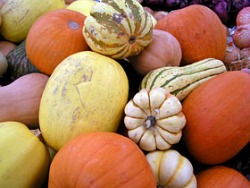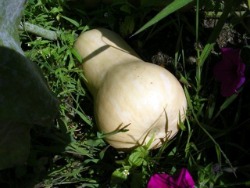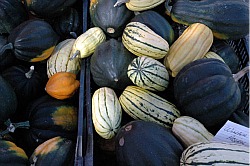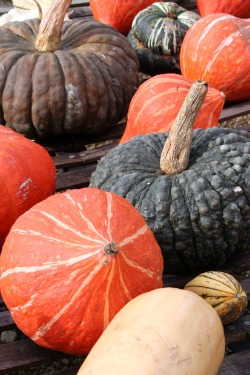
There is a broad range of winter squash types you can grow, including pumpkins.

Butternut squash is one of the most popular winter squash types and resists attacks from the squash vine borer insect.
No vegetable is more linked to the fall, winter and holidays than winter squash. "Squash" is actually taken from a Massachusetts Indian word, askutasquash, meaning "eaten raw". Although native Americas may have eaten some winter squashes raw, we enjoy cooking them in pies, cakes, curries, casseroles, cookies and soups. The variety of winter squashes available to cook with can be staggering. From huge pumpkins (technically a winter squash) to diminutive delicata squashes, there's a shape, size, color, flavor, and texture of winter squash for just about every dish.
This native American vegetable has been made famous for its role in the Three Sisters Garden (beans, squash and corn) used by many ancient peoples. Winter squashes were brought to Europe by early American settlers and have spread throughout the world. Now you can purchase winter squash varieties from as far as away as Australia, India and Japan.
What makes winter squash unique is its hard shell. Unlike summer squash, this gourd family vegetable has a tough skin that allows the fruits to be stored for months, enabling gardeners to enjoy winter squashes into the cold months. There are a variety of winter squash flesh colors and textures, all supplying good amounts of vitamin A, vitamin C, potassium and fiber. While winter squash has a reputation for needing lots of room in the garden to vine and run, there are newer varieties that are bushier and grow well in smaller spaces.
So grow a few winter squashes next year in your garden. Try some of the more unusual ones and enjoy sharing them with friends and family featured in holiday meals.
PlanningThere is a wide variety of winter squash types and varieties to choose from. This winter try eating a number of different ones from local markets and farmers, taking notes on your favorites. This will help you narrow down which ones to grow next year. Unless you have a large garden, you'll probably have to limit the number of winter squash varieties to two or three. Although there are new bush varieties on the market, they still take up a fair amount of space in the garden.
You can choose varieties based on the texture (dry or moist), flesh color (white to orange), or fruit size (small to large). All varieties listed below need 85 to 100 days or more to mature their fruits. While winter squashes can cross among themselves and with summer squash varieties, don't be concerned about creating a monster in your squash patch. Any foreign pollen that finds its way into your winter squash varieties won't exhibit its characteristics unless you save the seed from that variety and grow it out next year.

Delicata squash features small, oblong fruits that have a sweet, yellow flesh. Their size make them perfect for individual servings.

Kaboucha and buttercup squashes feature sweet, dry, orange flesh that's great for baking.
Here's a look at some common and uncommon varieties to try. I'll cover pumpkins in another article.
'Baby Blue' hubbard – Typically hubbard squashes can weigh over 20 pounds. 'Baby Blue' only weighs in at a manageable 4 to 5 pounds. It features a blue skin, dry, sweet, yellow flesh and is great for baking. 'Red Kuri' is a red skinned and fleshed hubbard that's great in pies.
'Burgess' buttercup – Buttercup squash feature a turban-like button on the bottom and dry, orange flesh and dark green or orange skin. ‘Burgess' is an heirloom, 5 pound variety with fiberless flesh.
'Cornell Bush' delicata – Delicata are uniquely shaped, small winter squashes that feature a green and white striped, 1 to 2 pound, oblong fruit with a sweet, moist, yellow flesh that’s great baked. This is a bush selection and easy to grow in small spaces. 'Sweet Dumpling' is a teacup-shaped version that's great stuffed.
'Early' butternut – Butternut squashes are perhaps the most popular winter squash for eating. They feature a smooth, tan-colored skin and moist, sweet, orange-colored flesh. They are great baked or in casseroles. Butternuts are less likely to be infected by the squash vine borer insect than other types of squash.
'Green Striped' cushaw – This bulb-shaped, 10- to 12-pound, light green striped squash features sweet, yellow flesh. It's good steamed or baked. The plant is resistant to the squash vine borer insect.
'Pink Banana' – These large (50 pound), cylindrical, banana-shaped squashes have a tan-colored skin and a dry, sweet yellow-orange flesh. They're good baked.
'Queensland Blue' – This Australian variety features dark blue, ribbed, 10- to 20-pound fruits with a dark orange, sugary flesh. They are good in pies and baked and are good keepers, too.
'Spaghetti' – This unusual squash produces an oblong, 4- to 5-pound, tan-colored skin and dry yellow flesh. The flesh is stringy like spaghetti, making a tasty dish when mixed with a tomato sauce.
'Sweet Sunshine' kaboucha – This buttercup-like squash has dry, sweet, deep orange flesh and orange skin. Kaboucha squashes also can have green colored skin. They are best baked or steamed.
'Table Ace' acorn – Acorn squash produces small, acorn-shaped, ribbed, green, gold, white or black skinned fruits with dry, pale yellow flesh. 'Table Ace' is a bush plant with a sweet, nutty flavor. Acorns are great for stuffing.
PlantingWinter squash need heat, moisture and fertile soil to grow their best. Amend the soil with compost before planting. Plant seeds or seedlings in the ground once the air temperatures reach 70 degrees F. In cool season areas, get a jump start on the season by starting seeds indoors 4 weeks before the last frost date. Two weeks before planting, form raised beds and cover them with dark green or black plastic mulch to preheat the soil.
Plant seeds or seedlings of bush varieties 2 to 3 feet apart in rows spaced 3 to 5 feet apart. For vining varieties, plant 2 to 4 feet apart in rows 5 to 8 feet apart. Some gardeners like planting in hills spaced 4 feet apart. Thin seedlings to 3 plants per hill after the true leaves form.
CareKeep winter squash plantings well weeded and watered. Consistent water is essential for the fruits to size up properly. If you're not growing the plants with plastic mulch, consider laying straw mulch down between plants to conserve moisture and keep weeds away once plants are established. Apply an organic granular fertilizer at planting and again when the plants start to vine.
If you have limited space, grow bush varieties or train vining varieties. To keep them in bounds, pinch off the growth tips of vines once fruits have set and start growing, physically move the vines, directing them back towards the plant, or grow vines along the garden edge and let them run into the lawn.
All winter squash need bees to pollinate their flowers in order to get fruits. If you don't have many bees in your area or the weather is cool and cloudy and bees aren't flying during flowering, pollinate the flowers yourself. Identify the male (straight stem behind the flower) and female (small fruits behind the flower). Before noon, pick a male flower, remove the petals and insert and swish the sexual parts (stamen) inside a female flower. Use the same male flower for 2 to 3 females. That's it, you're done.
Squash is attacked by a variety of insects and diseases. Squash bugs and squash vine borers are the most prevalent insects. Check under the leaves of developing plants for the reddish masses of eggs of the squash bugs and crush them. If you notice many grey squash bugs on the leaves, flowers and fruits, spray with pyrethrum or neem oil to control them. Control squash vine borers by planting butternut or cushaw squashes that resist their attacks. Cover young plants with a floating row cover to prevent the adult fly from laying eggs on stem. Inject Bacillus thuriengensis (Bt) in the stems of infected plants to kill the larvae, or physically remove the larvae by slitting open the stem and removing it. Cover the slit stem with soil to help it re-root.
Control diseases, such as powdery mildew, on winter squash by growing resistant varieties, spacing plants further apart, removing weeds, watering in the morning only, and removing infected plants. In general, rotate crops and clean up the garden well in fall to lessen the chances of insects and diseases attacking your plants.
HarvestHarvest winter squash when the fruits have turned the mature color for that variety. The skin should feel hard when you press on it with your fingernail. Harvest before a killing frost. With a sharp knife cut the stem 2 inches from the fruit. Wipe the fruits with a 10% household bleach solution to kill any disease spores, cure in a warm, well ventilated room for 2 weeks, and store in a 50 to 55 degree F dark room for 2 to 6 months depending on the type of squash. When cooking save the squash seeds for roasting. They taste as good, if not better, than pumpkin seeds.
Other winter squash growing stories:Winter Squash and Pumpkins
Hail to the Mighty Squash
Breeding Your Own Squash
 Charlie Nardozzi is an award winning, nationally recognized garden writer, speaker, radio, and television personality. He has worked for more than 30 years bringing expert gardening information to home gardeners through radio, television, talks, tours, on-line, and the printed page. Charlie delights in making gardening information simple, easy, fun and accessible to everyone. He's the author of 6 books, has three radio shows in New England and a TV show. He leads Garden Tours around the world and consults with organizations and companies about gardening programs. See more about him at Gardening With Charlie.
Charlie Nardozzi is an award winning, nationally recognized garden writer, speaker, radio, and television personality. He has worked for more than 30 years bringing expert gardening information to home gardeners through radio, television, talks, tours, on-line, and the printed page. Charlie delights in making gardening information simple, easy, fun and accessible to everyone. He's the author of 6 books, has three radio shows in New England and a TV show. He leads Garden Tours around the world and consults with organizations and companies about gardening programs. See more about him at Gardening With Charlie.
 Victory Seed Company has all the seeds you want for your best garden in 2024.
Victory Seed Company has all the seeds you want for your best garden in 2024.
For 25 years, the family-owned Victory Seed Company has provided the highest quality vegetable, herb and flower seeds to families across the country. We are passionate about providing you the best seeds available that give excellent germination, robust plants, and the harvest you want. With a catalog of over a thousand varieties, we have everything, and our prices are the kinds that we'd want to pay. We have hundreds of yesterday's heirloom vegetables, as well as today's award winning hybrid selections. Get to know us by visiting our website and browsing through our online vegetable seed catalog.